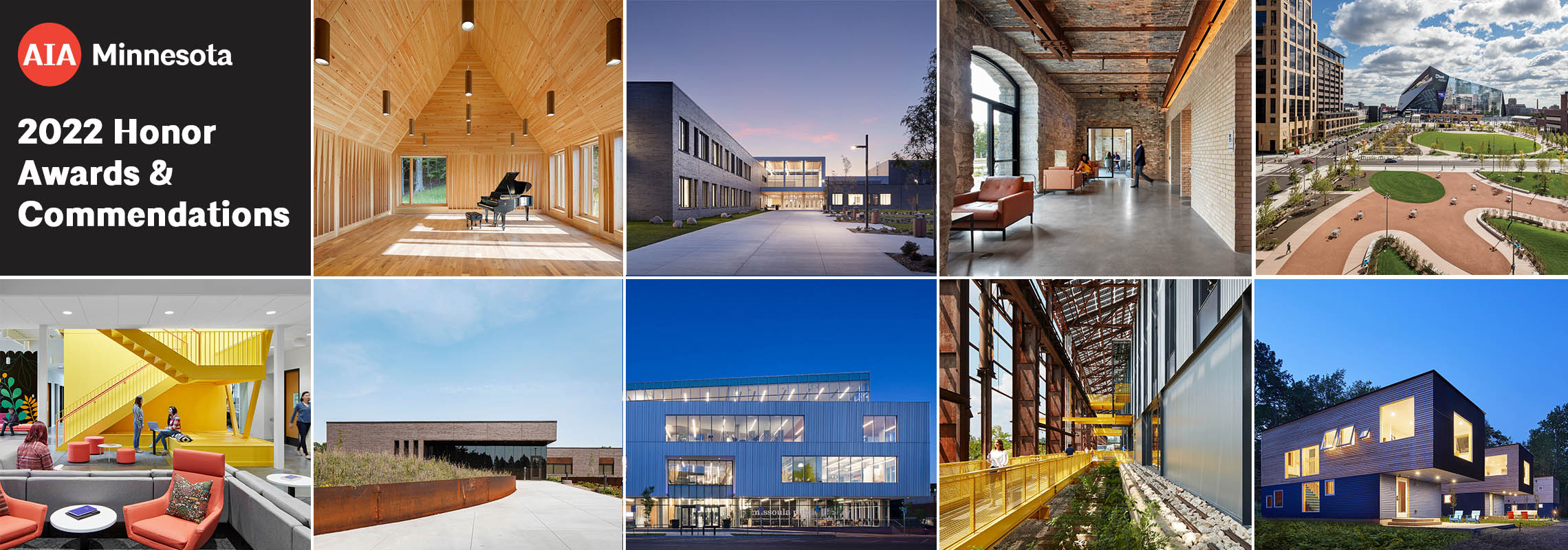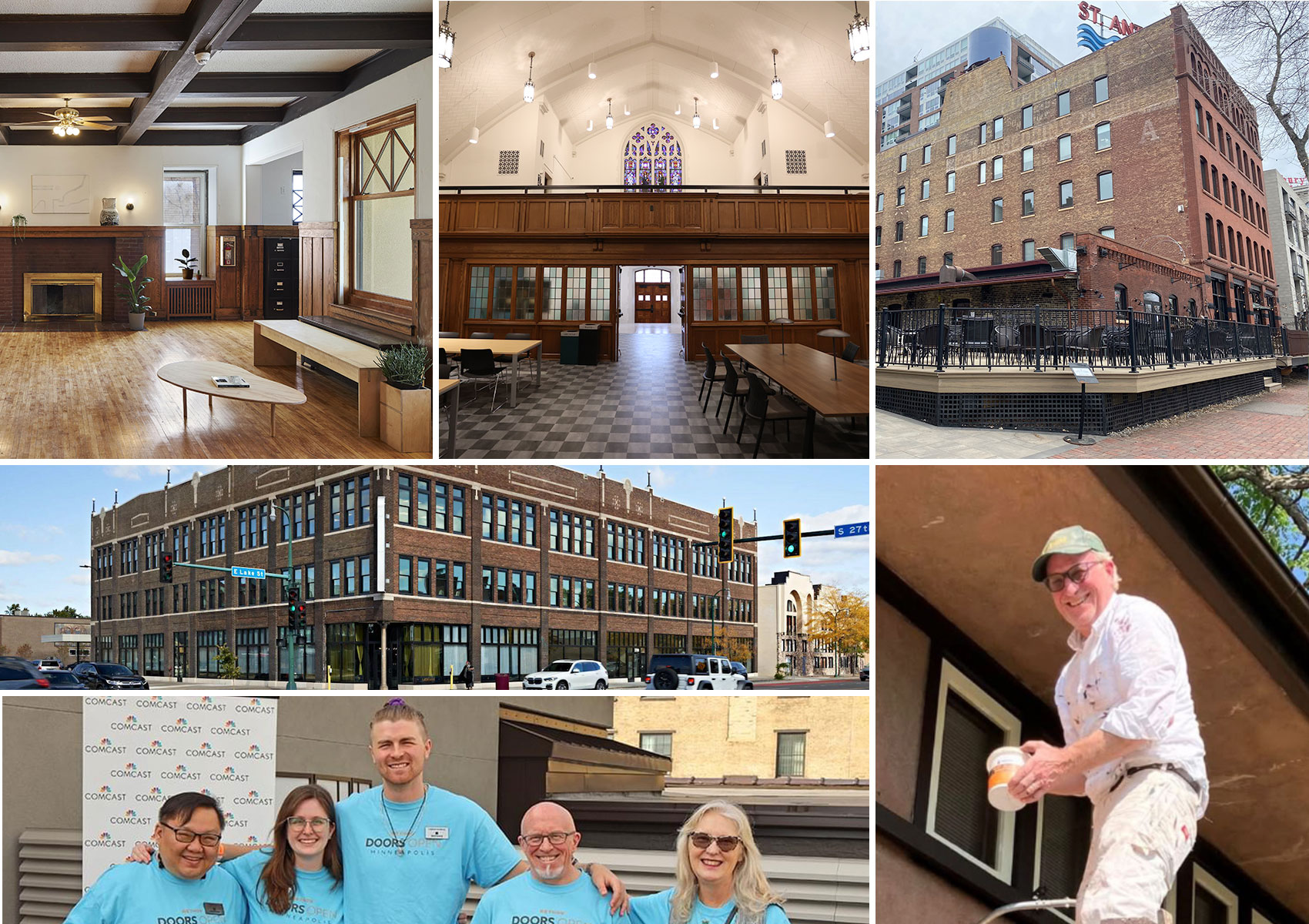MINNEAPOLIS, December 2, 2022— AIA Minnesota honored three projects with 2022 AIA Minnesota Honor Awards and six projects with Framework for Design Excellence Commendations. The awards and commendations were announced at tonight’s AIA Minnesota Awards Celebration at the Lumber Exchange in Minneapolis. Established by the American Institute of Architects Minnesota in 1954, the Honor Awards recognize outstanding built projects by AIA Minnesota members, or firms that are owned by AIA Minnesota members, that practice professionally in Minnesota.
The AIA Minnesota Honor Awards submissions were evaluated according to the AIA Framework for Design Excellence, in alignment with AIA Architecture Awards. Achievement within the Framework for Design Excellence requires a holistic approach to design, addressing the interdependence among people, buildings, infrastructure, and the environment. The Framework focuses on 10 categories: Design for Integration, Design for Equitable Communities, Design for Ecosystems, Design for Water, Design for Economy, Design for Energy, Design for Well-being, Design for Resources, Design for Change, and Design for Discovery.
The jury also awarded six AIA Minnesota Commendations for Framework in Design Excellence Achievement. Commendations recognize projects that excel in one Framework for Design Excellence measure, selected from the Honor Awards submissions.
Forty-six projects were submitted in 2022 and were evaluated by three internationally renowned architects: Philip Chen, FAIA, Annum (formerly Ann Beha) Architects, Boston; Chandra Robinson, AIA, NOMA, LEVER Architecture, Portland, Oregon; and Lawrence Speck, FAIA, Page Architects, Austin, Texas
The jury was delighted to see a wide variety of highly impactful civic, institutional projects serving their communities in rural, urban, and natural settings that set the stage for important conversations about design and architecture.
2022 Honor Award Recipients:
Project name: Marlboro Music Reich Hall
Excellence in Design for Integration, Well-being
Location: Marlboro, Vermont
Client: Marlboro School of Music
Firm of record: HGA
Project Team and Partners: HGA, architect, interior designer, structural engineer, and MEP engineer of record; CHA Consulting, Inc., engineer; Courtland Construction, LLC, general contractor; Kvernstoen, Rönnholm & Associates, Inc., acoustics; and Vermont Property Preservation Consultants, historical consultants.
Photo Credit: Albert Vecerka/Esto
Project Overview: This project is the addition of modern rehearsal spaces, a music library, staff offices, and gathering spaces for Marlboro Music, a renowned seven-week summer retreat for advanced classical training and musicianship. Inspired by both the Cape Cod cottage and the campus’s 19th-century farm structures, the new building is composed of four gabled forms clad in white-washed cedar siding, arranged around a courtyard green. In the wood-lined rehearsal rooms, sections of the walls tilt inward to prevent flutter echoes. The archive library features a similarly rural-modern simplicity with its wood ceiling, walls, cabinetry, and floor.
Project name: Sartell High School
Excellence in Design for Economy, Well-being, Integration
Location: Sartell, Minnesota
Client: Sartell-St. Stephen Independent School District 748
Firm of Record: Cuningham
Project Team and Partners: John Pfluger, AIA; Hailey Wrasman; Mike Mettee, Assoc. AIA; Dustin Schipper; Jeff Tonkin, AIA; Mike Jones; Origin Design (formerly IIW, P.C.); Design Tree Engineering and Land Surveying; True North Consulting Group; Schuler Shook, Inc.; Tremco, Inc.; reengineered, inc.; Rippe Associates; Kvernstoen, Rönnholm & Associates, Inc.; Augeo; Summit Fire Consulting; Bradbury Stamm Construction LLC; Judith Hoskins, Assoc. AIA; Scott Krenner, AIA; Daniel Grothe, AIA; Michael Berg, AIA; Bridget Hale; Tyler Whitehead, AIA; and David Motzenbecker.
Photo Credit: Corey Gaffer
Project Overview: This crisply contemporary high school in central Minnesota is arranged around a soaring, light-filled student commons with a series of bridges, tiered seating in the form of a learning stair, and a student-run coffee shop and school store. In lieu of a dedicated media center, the design integrates bookshelves and media technology into the common areas for increased use by students. Outside the general learning neighborhoods and specialized learning spaces, students can choose between small and medium-size group rooms, open lounge space, meeting tables, and outdoor seating for studying and socializing.
Project name: Water Works Park Pavilion
Excellence in Design for Integration, Water, Resources
Location: Minneapolis, Minnesota
Client: Minneapolis Park and Recreation Board, Minneapolis Parks Foundation
Firm of record: HGA
Project Team and Partners: Tim Carl, FAIA; Josh Stowers, AIA; Michael Hara, AIA; Robert Good, AIA, Michelle Hammer; Chrysanthi Stockwell; Andrew Sundal, AIA; Bobbe Norenberg; Jared Kovarik; Robert Johnson Miller; Jack Caughey; Amanda Nonnemacher; DAMON FARBER LANDSCAPE ARCHITECTS; MacDonald & Mack Architects; Kimley-Horn; Barr Engineering Co.; H+U Construction; 106 Group; Boelter Premier; Healing Place Collaborative; Owamni by the Sioux Chef; and Water in Motion
Photo Credit: Corey Gaffer
Project Overview: Built on and incorporating the foundations of late-19th-century flour mills on Minneapolis’s central riverfront, this two-level park building aims to reflect the site’s Indigenous, industrial, and post-industrial histories through preservation and interpretation. On the upper level, Owamni, Minnesota’s first full-service Native American restaurant, enjoys a panoramic view of the river and the Stone Arch Bridge. Below, on the parkway level, are visitor support spaces including all-gender restrooms, a mother’s room, and a meeting space. Everywhere, the lines between new and historic masonry are clear.
2022 Commendation for Framework in Design Excellence Achievement Recipients:
Project Name: Downtown East Urban Master Plan
Commendation for Excellence in Design for Economy
Location: Minneapolis, Minnesota
Client: City of Minneapolis; Wells Fargo Bank, NA; Minnesota Sports Facilities Authority; Downtown East Investors, LLC; RR MPLS DR, LLC; Ryan Companies; Weidner Apartment Homes
Firm of Record: Ryan A+E, Inc.
Project Team and Partners: Michael Rother; Joshua Ekstrand, AIA; Michael Ryan, AIA; Rolfe Stevens; Karl Drecktrah, AIA; Ayman Arafa, AIA; Ryan Larson; Kaitlin Veenstra; Heidi Mapes, AIA; and Jason Hansen
Photo Credit: Paul Crosby, Chad Holder
Project Overview: The Downtown East Urban Master Plan set the stage for the largest redevelopment project in Minneapolis in recent decades, infilling five underutilized blocks between the Central Business District, the Historic Mill District, and U.S. Bank Stadium with new apartment buildings, mixed-use office towers, a hotel, and a parking ramp anchored by a 4.2-acre public green called The Commons. The execution of the master plan has created a sense of place for a section of downtown formerly characterized by surface parking lots and has spurred additional transit-oriented development in the area.
Project Name: Family Tree Clinic
Commendation for Excellence in Design for Economy
Location: Minneapolis, Minnesota
Client: Family Tree Clinic
Firm of Record: Perkins&Will
Project Team and Partners: Perkins&Will; Victus Engineering, Greiner Construction, Inc.; BKBM Engineers; Grand Real Estate Advisors; KNOCK, inc.; and Fluid Interiors
Photo Credit: Nathan Anderson Photography, Gaffer Photography, Corey Gaffer
Project Overview: This is a 17,000-square-foot clinic for a nonprofit that provides specialized care and services for LGBTQ+ individuals. A relatively simple, economical building, it nonetheless expresses its intentions to be a permanent presence in its urban neighborhood with an elegantly detailed brick exterior and healing-themed street and courtyard murals by BIPOC and LGBTQ+ artists. The interiors are equally colorful, with vibrant murals, stairs, and furnishings in the common areas, while trauma-informed clinical spaces balance privacy and a sense of safety with plentiful natural light.
Project Name: Hennepin County Medical Examiner Facility
Commendation for Excellence in Design for Well-being
Location: Minnetonka, Minnesota
Client: Hennepin County
Firm of Record: LEO A DALY
Project Team and Partners: LEO A DALY
Photo Credit: LEO A DALY
Project Overview: This low-slung, brick-clad building aims to be one of the most innovative facilities in the nation for forensic death investigation and training. Nestled into a woodland landscape, its 64,000 square feet of laboratories and administrative spaces are designed to support doctors and staff who experience mental stress and physical strain at much higher levels than most professionals. The architects focused on daylighting, advanced indoor air quality measures, and ergonomics, as well as providing indoor and outdoor spaces with immersive views to surrounding prairie, wetlands, and forest.
Project Name: Missoula Public Library New Main Library
Commendation for Excellence in Design for Equitable Communities
Location: Missoula, Montana
Client: Missoula Public Library
Firm of Record: MSR Design with A&E Design
Project Team and Partners: A&E Design, architect of record; and MSR Design, lead design architect & interior designer
Photo Credit: Lara Swimmer Photography
Project Overview: This library’s unique setting—in a downtown nestled in a valley at the hub of five mountain ranges—inspired its design. The exterior concept evokes the region’s geological layers, while the glass and metal cladding reflect Missoula’s fast-changing weather. Inside, an atrium stair offers a kind of mountain climb leading to an expansive rooftop patio view of Mount Sentinel. The library is also unique for the mix of free community resources it houses: Missoula Community Access Television, Families First Learning Lab, and the University of Montana spectrUM Discovery Area and Living Lab.
Project Name: RIDC Mill 19
Commendation for Excellence in Design for Change
Location: Pittsburgh, Pennsylvania
Client: Regional Industrial Development Corporation
Firm of Record: MSR Design
Project Team and Partners: MSR Design
Photo Credit: Corey Gaffer
Project Overview: This project is the repurposing of the steel skeleton of an abandoned steel rolling mill on the Monongahela River as an outer shell for new high-tech office, lab, and manufacturing facilities. The project removed the mill’s failing sheet-metal skin, used the sloped roof to install the largest single-slope glass PV array in the U.S., and created a network of plazas, elevated walkways, balconies, and gardens around the new structures that immerses tenants and visitors in the industrial ruins. RIDC Mill is the first completed project within Hazelwood Green, the redevelopment of a 170-acre brownfield site into a mixed-use innovation district.
Project Name: Wild Rice Retreat
Commendation for Excellence in Design for Well-being
Location: Bayfield, Wisconsin
Client: Heidi Zimmer
Firm of Record: Salmela Architect
Project Team and Partners: David Salmela, FAIA; Darin Duch; Kai Salmela, AIA; Travis Van Liere Studio, landscape architect; Kraus-Anderson, construction manager; Zimmer Development, LLC, developer; and BKV Group, interior design consultant
Photo Credit: Corey Gaffer
Project Overview: This project is the reimagining of a former restaurant on a wooded shore above Lake Superior into an arts and wellness retreat with the addition of 19 guest cabins and three additional buildings for yoga and sauna or meditation. The new structures, designed by the same architects who had shaped the restaurant nearly 20 years earlier, feature the gable roofs and cedar lap siding of Scandinavian boathouses and farm buildings, with interiors lined in locally sourced basswood. The three types of cabins range in size from 312-square-foot Rice Pods to 1,548-square-foot, two-level Treehaus units.
The American Institute of Architects Minnesota, founded in 1892, is dedicated to strengthening our communities, improving our built environment, and providing exceptional design. For more information on the organization and Minnesota architectural firms, reference our website, visit our Facebook page, and sign up for ENTER, our digital biweekly on shaping a better built environment for Minnesota.


